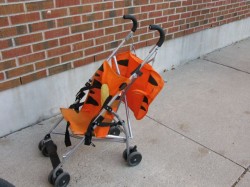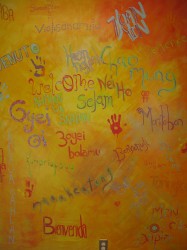Knitnut.net. Watch my life unravel...

|
Posted by zoom! on November 24, 2009, at 5:49 pm |
I spent yesterday at the Homelessness Forum, which was sponsored by the Alliance to End Homelessness.
This is my third year attending and blogging about this event (see 2007and 2008). I like it because it’s free. Actually, that’s an over-simplification. Because it’s free, it attracts the kind of people who might not normally attend conferences, including low-income people, front-line workers, and me. I like that. I rode the elevator up to the fourth floor with a homeless man who said he was there for the free lunch. (I noticed he stayed past lunchtime though.)
I also like the interesting mix of presenters. I’m always impressed with the young people on the panels. This year, an articulate young woman named MJ described her own harrowing journey to the streets. It’s pretty bad when the streets offer a safe refuge from your family.
The keynote speaker was Dr. Jeffrey Turnbull, Chief of Staff at the Ottawa Hospital and President-Elect of the Canadian Medical Association. He believes the reason we tolerate poverty is because of a deep-seated prejudice against the poor. Essentially we hold people responsible for their own poverty, despite the fact that there is ample evidence showing poverty is a structural problem, not an individual problem. Members of some groups are far more likely to live in persistent poverty, including Aboriginals, single parents, people with mental or physical disabilities, recent immigrants, youth, and unattached elderly people.
The Forum included an Aboriginal panel, a panel on Child, Youth and Family Homelessness, a short documentary filmed right here in Ottawa, and a presentation by two residents of a program in Toronto in which residents themselves set out to get their NIMBY neighbours on board – and succeeded.
They introduced the concept of Table Talks this year. You could pick one of about a dozen tables to sit at during lunch, each with a different focus. I sat at the Cardinal Suites table. That’s the new Shepherds of Good Hope facility opening up in my neighbourhood. (The Cardinal Suites, by the way, is being renamed The Oaks.)
I got to see the blueprints and learn more about the three programs, especially the Managed Alcohol Program. The Oaks is two buildings, next door to one another. The smaller building and the top three floors of the larger building will be the apartments and rooms that house the residents. The ground floor of the larger building will house the admin functions, staff offices, and common areas for both buildings, such as the kitchen, dining room, TV rooms, exercise room and wine-making room.
The Managed Alcohol Program provides hourly 5-ounce doses of home-made wine to its residents. This is enough to keep them from going into withdrawals, but not enough to get them drunk. That’s because they are formerly street-entrenched alcoholics who typically spent many years consuming five to seven bottles of cheap sherry, or the equivalent, each day.
I used to work at Bright’s Wines in the Market when I was young. I sold a lot of Bright’s 67 and St. George’s Sherry to men who came in every hour or two throughout the day. On a bad day they might have had to drink Aqua Velva or other substances that are high in alcohol content but not intended for human consumption. Five ounces of wine every hour is nothing to these guys.
If the Managed Alcohol Program were to buy that wine at the liquor store, it would cost them about $150,000 a year. By making it themselves, they save $130,000 a year.
Interestingly, the program also provides tobacco to their residents. In the early days of the program, they realized that they were losing clients to the streets because of their addiction to tobacco. Even though their drinking was being managed, they were back out on the streets, panhandling for smoking money. Pretty much all their clients smoke. This is just an interesting fact of life. There’s a really high correlation between smoking and mental health issues, and between other addictions and smoking. (I’m not sure why that is, but maybe it’ll be a topic for another day.)
To be eligible for the program, a client must have a long history of street drinking, complex health problems that are not being addressed because of the alcohol use, frequent use of emergency services (police, ambulance, etc.), and be causing concern in the community because of alcohol-related behaviours.
Residents are required to contribute $100 of their $118 personal needs allowance toward the cost of alcohol.
It may sound counter-intuitive, but this is a harm reduction program that has proven health and quality-of-life benefits for the participants, along with economic benefits for the rest of us. This program saves the City of Ottawa 3.5 million dollars a year in things like emergency services.
Posted by zoom! on November 23, 2009, at 5:03 pm |
About a month ago I heard somewhere that something was about to happen, astrologically, that would mark the beginning of several years of difficult times for those of us born under the sign of Libra.
Now, I don’t believe in astrology. But I couldn’t help remembering that last year Megan, a fellow Libran, blogged about the astrological forecast for Librans for 2009. Apparently we were all going to face some kind of career chaos. And then – three months later, in March 2009 – I got laid off!
So it kind of unnerved me a bit to hear that I was now entering a period of several years of difficulties.
Especially when you take into account the kind of year I’ve already had, what with breast cancer and back surgery and the layoff and everything. You don’t want to emerge from all that upheaval only to hear that your bad luck is just about to begin.
Despite my insufferable natural optimism, I confess to being a little nervous these days. Jumpy. I’m scanning the shadows, searching for things that might be waiting to ambush me. And now that I’m looking for them, I realize they’re everywhere!
First, there was that breast MRI a few weeks ago that showed the new lump. “It might be nothing,” said the doctor, “or it might be cancer. We’ll just wait six months and see.”
Meanwhile, I had an ultrasound the other day that revealed a big old fibroid tumour in my uterus. Fibroids are almost always benign, so that’s good, but I’m probably looking at some kind of surgery to get rid of it.
And then, last night, at 1:00 in the morning, I had an MRI of my back at the General. This was just routine follow-up by the neurosurgeon who did my back surgery. I don’t know why, but after seeing my images, the MRI radiologist ordered a more extensive set of images – with a dye injection – to be performed tomorrow morning.
In the past, when I was ridiculously healthy and Libra was enjoying an extended period of grace and good fortune, I would have seen this as just a nuisance. But now? Now I’m wondering if this is IT. The Big One. The Beginning of the End.
What do the rest of you Librans think? How’s your luck holding up these days? How’s your health? You think I’m being paranoid, or is the universe really trying to kill us all off?
Posted by zoom! on November 21, 2009, at 2:41 pm |
 Youville child care staff in a quiet moment I recently had the privilege of taking a tour of Youville Centre, as part of the United Way’s Seeing is Believing tour.
Youville is a combination school and child care centre for teen moms. It’s bright, clean and cheerful, and it’s alive with the energy of 48 teenagers and their 50 or so babies and toddlers.
I love what Lara from Gliding Through Motherhood said:
I became a mother at the age of 30. I was married to a wonderful man, owned a house and had an incredible support network with both our sets of parents here in town and willing to help. And, it was hard.
As for me, I was 25 when I tackled the combination of single motherhood and school, and I remember how much commitment and focus and time it took. I remember how impressed I was with myself for just getting it all done, day after day, and for sticking with it year after year. All these years later, I’m still impressed.
So I absolutely bow down to anyone who can manage it all while they’re still a teenager. It’s a phenomenal achievement. As Bob LeDrew so succinctly put it, “I couldn’t even be trusted with my own skin care at fifteen.”
 Most teens still need a parent to roust them out of bed each morning – they’re nowhere near ready to be the one doing the rousting. But these teenage women are getting up when the alarm goes off, getting themselves and their babies ready for the day, getting across town on the bus, going to school all day, and spending their evenings and weekends being moms, cooking, cleaning, going to laundromats, paying bills, running households and doing homework. Most teens still need a parent to roust them out of bed each morning – they’re nowhere near ready to be the one doing the rousting. But these teenage women are getting up when the alarm goes off, getting themselves and their babies ready for the day, getting across town on the bus, going to school all day, and spending their evenings and weekends being moms, cooking, cleaning, going to laundromats, paying bills, running households and doing homework.
And, almost invariably, they’re doing it in the quicksand of poverty. Poverty makes everything so much harder. When you have a reasonable income, you can make a lot of problems go away just by throwing money at them. But when you’re poor, those problems just keep piling up and getting worse. Poverty even has a way of transforming things that shouldn’t be problems into problems. A child’s growing feet, for example, are a problem if you can’t afford new shoes.
Youville can’t lift these moms out of poverty, nor can it ensure that they don’t have to deal with the hard choices, limited options, extra work and chronic stress that poverty forces upon people. But it does its best to help them do their best with what they’ve got. A good example of this is the cooking classes, which teach them how to make meals with basic equipment and the kind of food that you get from the Food Bank.
In addition to poverty, teen moms might also be dealing with stigma, social isolation, stress, and just a general lack of the experience and life skills that make managing adult responsibilities easier, as well as the normal challenges of adolescence.
Youville provides child care, high school classes, parenting classes, counseling services, cooking classes, a nutritious breakfast and lunch for both mothers and children, Food Bank services, academic and career counseling, housing support, and help getting into post-secondary education. The moms also benefit from having a peer group and spending their days among friends who can relate to their reality.
Ultimately it’s up to the young women to do the hard work necessary to achieve their educational goals. And most of them do. There’s a wall, at Youville, with photos of all the graduating classes from over the years, and the graduates look absolutely radiant and deservedly proud of everything they’ve accomplished so far.
You can make a donation to the United Way here.
Posted by zoom! on November 20, 2009, at 8:05 am |
On Wednesday afternoon, after 18 days of frenetic writing, I finished my Nanowrimo novel! I typed my 50,000th word, completed the sentence, wrote THE END and exhaled deeply. Woohoo. I hit the word count button, and it said my novel was 50,023 words long.
I don’t know what I expected…some sort of hoopla, I guess. Fireworks. Marching bands. Jack-in-the-boxes. Dancing squirrels. Special effects. Something more than a profound sense of relief that I don’t have to keep writing this godforsaken book.
I flipped over to the Nanowrimo site and pasted my entire novel into its word count box, for word-count verification. Not only was there no hoopla, but it said my novel was only 49,821 words long. What?? I wasn’t finished?? How could that be??
So I flipped back to my novel, picked a paragraph at random, and padded it. By the time I was done, Nanowrimo said my novel was 50,025 words long. Still no hoopla, but at least it’s over.
I was planning to embark upon a second, better novel as soon as this one was done, but I can’t bring myself to start it just yet, not while the stench of the last one is still in my nostrils.
I honestly didn’t think myself capable of writing such a stinker of a book. But I did it, and I’m proud of it. I blasted right through my writer’s block, and I learned a lot from the process, including:
- There’s a big difference between wanting to write and actually writing.
- A good novel needs good bones.
- In order to develop interesting, fleshed-out characters, you can’t invest too much of yourself in caring whether they’re ‘good’ or ‘bad’ people.
- In order to make progress while writing a book, you can’t perfect each sentence as you go, even if the thing you love most about writing is a well-crafted sentence. Save that for the second draft.
- When you feel your book is irredeemably bad, it’s hard to keep investing the time and energy to make it longer.
- You still get a good buzz and a sense of accomplishment from reaching your goal, even if your book stinks.
- There’s a first-draft sweet point where you strike the right balance between quality and quantity. I’m going to find it in my next book.
What next? I’m going to wait a couple of weeks and then I’ll read my first draft to see if there’s anything I want to salvage from it. I’m not going to do a second draft; this book has already served its purpose and there’s nothing more to be wrung out of it. I will take advantage of the free offer for the publishing of a single copy of the book, but I will hide that copy well and destroy it before I die.
Posted by zoom! on November 18, 2009, at 10:24 am |
Being unemployed has some perks. For example, I get to spend a lot of time working on my godawful Nanowrimo novel. And I get to go for long walks around the Experimental Farm on these glorious sunny afternoons, and be part of the energy and noise of huge flocks of crows and geese preparing for winter. I’m telling you, it’s strangely thrilling.
And I get to go on the Seeing is Believing tours, visiting organizations that receive funding from the United Way. So far I’ve toured Youville (a school and child care centre for teenage moms), the Loeb Centre (a vocational centre where adults with developmental disabilities work and socialize), and the Youth Services Bureau’s emergency shelter for young women.
I never had a chance during the whole time I was working and donating to United Way to go on these tours and see what my donations were supporting. I assume that some of you are in the same boat, so I’m going to tell you a little bit about what I’ve seen. Today I’ll tell you about the emergency shelter; the others will follow.
 Welcome in many languages: the wall as you enter the building The emergency shelter for young women is just one of many, many programs and services offered by the Youth Services Bureau. They also provide mental health services, employment services, justice services, and an array of community services to youth in Ottawa. But this emergency shelter for young women is what the United Way supports – fully one-third of the shelter’s budget comes from those of you who donate to the United Way. It’s the only one of its kind in Ottawa.
When I was fifteen years old, which was long before this shelter existed, I left home and never went back. I was scared. I knew so little about the city and the world and my own options. I was a sad, shy girl from a small town and I was afraid to ask anybody for any kind of help.
I was also very, very lucky – somebody stepped in and helped me. She took me into her home and took care of me. She helped me explore my options, and got me connected with the Children’s Aid Society. I became a crown ward of the CAS, which ensured that I had some basic income, and therefore some options, for the next few years. I lived with foster parents until I was seventeen, and then I was out on my own after that.
It scares the pants off me to think of how differently things could have turned out if that young woman hadn’t helped me. I was so small and naive and vulnerable. I don’t think there were any services out there specifically for young girls in my situation.
For a young girl in the same situation now, she would have the Young Women’s Emergency Shelter, with its small bedrooms and shared bathrooms and, most importantly, its youth workers to help her navigate the complicated system so she can become independent. During that incredibly vulnerable period, it’s essential that young girls have a safe place to stay and access to information about their options
There’s a big, bright common area and a series of small bedrooms, each with a bed, a desk, a closet and a window. We peeked inside one of them, and I got a lump in my throat when I saw the meager belongings of the young girl whose room it was: a jacket slung over a chair, a few clothes hanging in the closet, some papers, a ball of orange yarn and a partially knit hat on the desk. It was the knitting that got to me. The fact that she knits. Who is she, this homeless knitting teenager?
The shelter hosts a wide variety of clients, including poor, middle-class, straight, lesbian, trans, addicted, mentally ill, recent immigrant, white and visible minority women. The only things they all have in common is they’re young, female and need somewhere to stay. They range in age from 12 to 21. The average age is 17. Ninety per cent of them have some kind of abuse in their background.
They’re not allowed to stay long in the emergency shelter – typically less than a month. Just long enough to figure out where to go next. Where do they go when they leave? Most qualify for Ontario Works (welfare) and go into the private rental market. Ontario Works allocates them $335 a month for housing costs, which typically means a rooming house, or a low-end shared apartment. They go to school and get part-time jobs. A handful of them go into transitional housing, which is upstairs in the same building as the shelter. They get a bachelor apartment (some of which have their own bathroom). They can still access the services of the shelter if they need to. They can stay there for up to a year.
It doesn’t sound like much, does it? But when you’re a scared kid with no money and nowhere to go, it’s everything.
You can make a donation to the United Way here.
Posted by zoom! on November 17, 2009, at 10:32 am |
GC thought it would be a good idea for us to get up at 4 o’clock in the morning and drive to the Gatineaus to watch the Leonid meteor shower. In some odd twist of logic, we stayed up late since we had to get up early. Then GC read a few pages of Flashforward to Duncan and me. Duncan loves story time, which was cut short last night because GC read himself to sleep in just a few moments.
Ever since we left him alone for a night a few days ago, Duncan has been a little bit needy at bedtime. He insists that we sleep facing each other, and that we sleep with both of his paws on my face (one on my cheek, the other on my lips) and that his nose be directly under my nose, so he can inhale the air I’m exhaling. Unfortunately I keep forgetting to trim his nails, and am only reminded of it at bedtime when he’s got both paws and all his sharp pointy claws digging slightly into my face.
Before long, Duncan and GC were both snoring but I was still awake. Eventually I drifted off, and the next thing I knew, the alarm was sounding. It was four o’clock. In the morning. GC leapt out of bed, ready for meteor showers! Duncan leapt out of bed, ready for breakfast! I burrowed further into the bed and groaned.
But with a little cajoling I got up and put on lots of warm clothes and joined GC for the trek up to the Gatineaus to see the meteor shower. After all, he had cheerfully gotten up at the crack of dawn all those mornings to go crow chasing with me.
The thing is, when we went crow chasing, we were rewarded with the spectacle of thousands of crows. The meteor shower activity was a little on the light side, if you ask me. We craned our necks and stared at the sky and every couple of minutes we saw a shooting star.
On the drive back to Ottawa, GC admitted that perhaps he had been lead to believe the meteor shower activity would be a little more spectacular than it actually was. The internets lied.
But – on the bright side – I got to make a wish on a shooting star and I’m pretty sure it’s going to come true.
Posted by zoom! on November 16, 2009, at 5:45 pm |
They’re saying the two downtown fires at the women’s shelter and the women’s rooming house are unrelated. Foul play is being blamed for at least one of them. Regardless of how they happened, one woman’s dead and an awful lot of women on the bottom rungs of the socio-economic ladder are suddenly even more precariously housed. Ottawa’s shelter system was already stretched pretty thin, especially for women, and it needs our help now.
Some of the local bloggers have gotten involved by finding out what’s needed, and getting the word out.
Bob LeDrew has offered to spend a couple of hours on Friday driving around Ottawa and picking up donations of various kinds for women’s shelters. If you’d like to help, please visit Bob’s blog or Ian Capstick’s blog for more information. Laura Payton tweets that you can also drop off donations to the Hill Times at 69 Sparks Street by Friday.
Posted by zoom! on November 16, 2009, at 1:45 pm |
It was a busy, busy weekend, including a brief trip to Montreal, the TimeRaisers event on Saturday night, and the Vintage Clothing Sale on Sunday, with knitting, novel-writing, novel-reading and breakfast eating crammed into random little pockets of time.
TimeRaiser was even better this year than last, because they simplified and streamlined the whole thing. It’s an art auction, but you bid volunteer hours instead of money. Every piece of art sold for the maximum bid (75 to 125 volunteer hours).
 Cops at Night by Shaan Syed I bid on three pieces, but there was one in particular that grabbed my attention. It was a small oil painting by Shaan Syed, entitled Cops at Night, depicting a mob of cops in action.
There was a young couple also very interested in the same piece. After the bidding ended, I asked them what their interest in it was. It turns out that he is a criminal defense lawyer, and he wanted to hang it in his office; he thought some of his clients might be able to relate to it. They asked me what my interest was, and I told them I’d blogged about an incident last year, and this piece reminded me of it.
“Was that on Bank Street, outside Hartman’s?” asked the young woman. It turned out she’d read it!
Anyway, we chatted about power imbalances and police brutality and how the fact that we’re all carrying cameras and video recording devices might be helping to keep bad cops more in check than they would be otherwise. We exchanged business cards, in case I ever need a lawyer, or they ever need a blogger.
We agreed that this particular work of art probably appealed to a limited number of people, but those who wanted it wanted it a lot, and for the right reasons. There were only four bidders on it. The way it works is that if multiple bidders on a piece are willing to bid the maximum number of volunteer hours (in this case, 75), one of them is drawn at random. In our case, the lawyer and I each had a 25% chance of winning it. I would have been almost as happy if he had won it. As it turned out, neither of us did. I know nothing about Christine, the woman who won, but maybe she had a good reason for wanting it too.
 GC's Winning Art from 2008 TimeRaisers GC was one of several people who received his winning art from last year at this event. He had to go up on stage for a presentation by CBC’s Amanda Putz. His piece is quite impressive: It’s a large night scene, with a hockey net way at the other end of a frozen pond. And because the event was held at the National Gallery (a last minute shift from the War Museum, out of respect for the striking workers there), GC can now say he owns a piece of art that hung at the National Gallery of Canada. He put in 185 hours of volunteer work at the Shepherds of Good Hope for this piece.
Speaking of the Shepherds, we ran into Ann MacDonald, the Shepherds’ volunteer coordinator, at the TimeRaisers event, and she told me that they’d printed and blown up this blog post and put it up on their bulletin boards. I liked that!
Posted by zoom! on November 14, 2009, at 7:01 pm |
Good news! Karen’s homeless cat friend has found a home in the country where he has the run of the barn and the house! His new staff includes a Burmese Mountain Dog and some chickens. Life probably doesn’t get much better than that.
 Barkley Speaking of Burmese Mountain Dogs, I met the cutest puppy ever this weekend. His name is Barkley and he was spending the weekend with GC’s brother, Charlie, who is a professional dog sitter from Toronto. All dogs adore Charlie. He speaks their language. Anyway, Barkley is seven months old and he’s the product of an in vitro conception between a Burmese Mountain Dog and a Miniature Poodle. (You can see the logistical problems that led to the necessity of an in vitro intervention.)
Julia has asked me to help spread the word for a cause she and I are particularly partial to. Next Friday November 20th, Breast Cancer Action is putting on a gala to raise money to support services and programs for women living with breast cancer in the Ottawa area. It’s a dinner dance with a live and silent auction, hosted by Max Keeping. Read more about Breast Cancer Action, and about the Gala and how to buy your tickets.
Posted by zoom! on November 13, 2009, at 12:49 pm |
 Yesterday afternoon I was walking around the Experimental Farm, soaking up Indian Summer and watching the Canada Geese and the crows, when I noticed a peculiar bird way up high in a tree. He was sharing the tree with two crows. He looked like a crow too, but he was much bigger. He was closer in size to an owl. Yesterday afternoon I was walking around the Experimental Farm, soaking up Indian Summer and watching the Canada Geese and the crows, when I noticed a peculiar bird way up high in a tree. He was sharing the tree with two crows. He looked like a crow too, but he was much bigger. He was closer in size to an owl.
I took a whole bunch of pictures of him because he was so unusual. For awhile I thought maybe he really was a crow, just a freakishly large one. But he also seemed to have a loose neck, if you know what I mean. Crows tend to have pretty firm necks. But maybe he was just a freakishly large crow with an unusually wobbly wattle.
 But then, while I was standing below the tree, taking pictures and trying to decide what else he could possibly be if he wasn’t a crow, one of the crows said to him “CAW! CAW!” and he replied, “HONK! HONK! HONK!” and flew away. But then, while I was standing below the tree, taking pictures and trying to decide what else he could possibly be if he wasn’t a crow, one of the crows said to him “CAW! CAW!” and he replied, “HONK! HONK! HONK!” and flew away.
He was definitely not a crow, because crows don’t honk. So what was he?


|
|


























Popular Posts